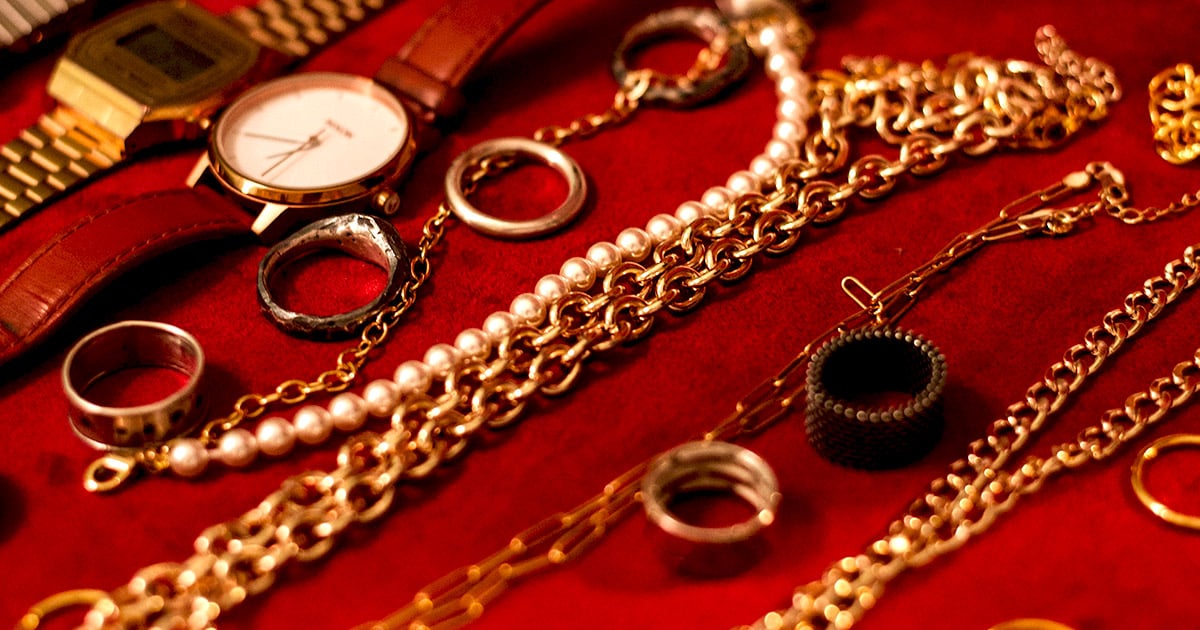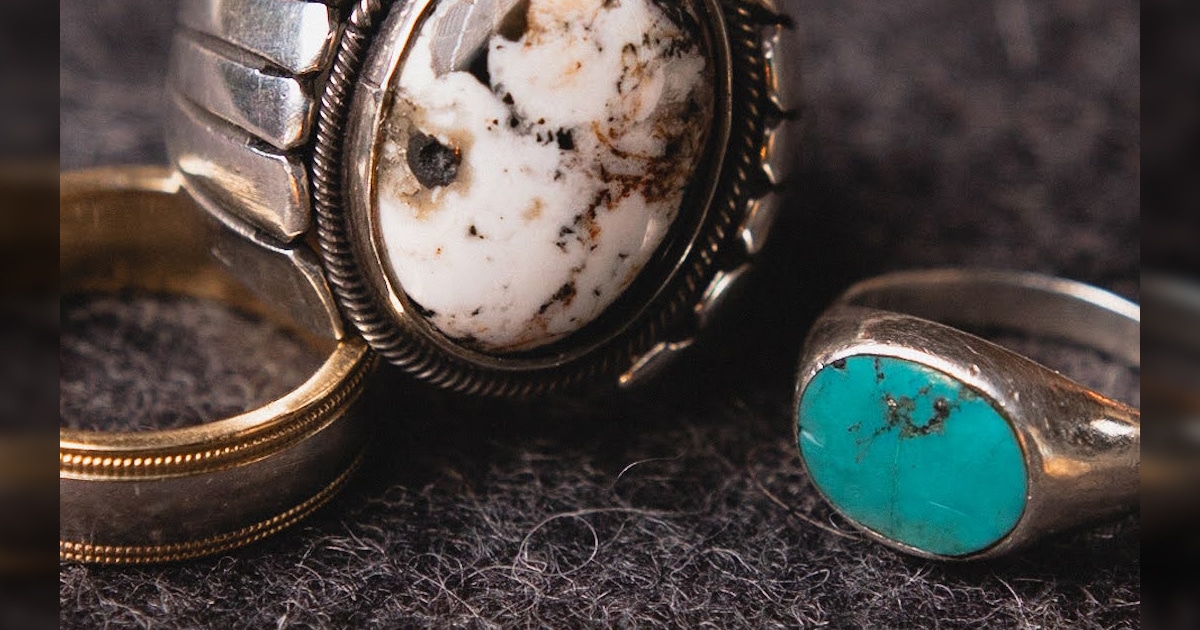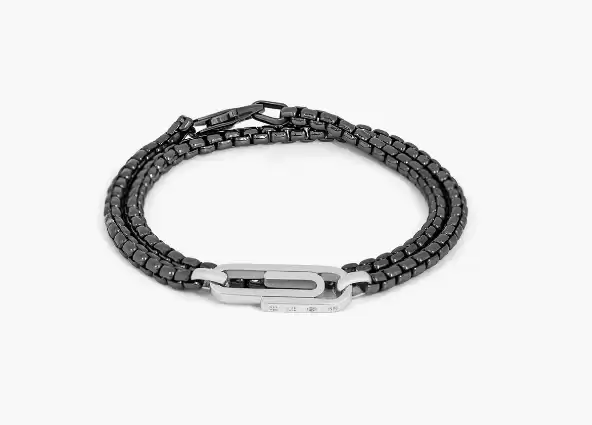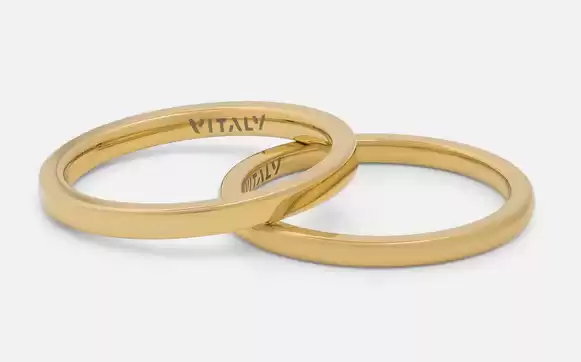Originally made solely to mimic fine jewelry, today costume jewelry is a wide-ranging category of body ornamentation for guys and ladies.
However, some people view these adornments as cheap, low-quality products because they aren’t made with precious metals or real gems.
This can be true, but if you pay attention to the metals used in costume jewelry, it can be a wonderful, long-lasting addition to your wardrobe—and you can avoid items that’ll turn your skin green!

Today, we’re going to explore the metals used in costume jewelry in detail, but first…
What Makes Costume Jewelry for Men Different from Regular Jewelry?
For the most part, if it isn’t made with precious metals or real gems, it’s costume jewelry.
An important point here is that good costume jewelry isn’t necessarily “worse” than regular jewelry. It’s just a different category meant for a different kind of use.
High-end jewelers like Tiffany make pieces out of non-precious metals for durability purposes, like their stainless steel and titanium Paloma’s Caliper Cufflinks, while Coco Chanel and Yves Saint Laurent are famous for designing intricate costume pieces.
Conversely, high-value jewelers like Jaxxon, GLD, and Gthic make both costume jewelry and fine jewelry. GLD’s round-cut earrings, for example, come as CZs or actual diamonds.
The misconception that fashion jewelry is always cheaply made is the reason why so many jewelers don’t even categorize their stainless steel, titanium, and tungsten pieces as costume (despite the fact these metals are non-precious).
A costume or fashion piece can be just as finely crafted as fine jewelry.
Another way to look at costume pieces is as “everyday jewelry” that, while more affordable, aren’t just knock-offs. Meanwhile, fine jewelry is often reserved for special occasions like anniversaries or graduations.
What Are Some Materials Used to Make Costume Jewelry?
The majority of costume jewelry is made from non-precious stones, plastics, glass, and base metals. High-leaded glass and man-made cubic zirconia, for example, are often used as a diamond simulant.
We’re going to focus on metals today, and how each is used.
What is Metal Costume Jewelry Made Out Of?
Sometimes, costume jewelry base metals are colored to look like real gold or silver, which we’ll go into more detail on later!
However, not all costume pieces are made to “fake” a precious metal. A lot of high-end pieces use stainless steel for durability or copper-based metals for an antique look, like in the David Yurman Statue of Liberty Bracelet.
Here are the metals used in costume jewelry, plus some pros and cons. (One pro that all of these metals have in common is that they’re affordable, so we won’t mention it each time!)
Brass
In recent years, the use of brass has become increasingly popular, thanks to its affordability and natural gold-like color. The majority of artisanal jewelry currently on the market is made from this metal.
Brass is a combination of zinc and copper. If a particular piece has more zinc, it’ll be stronger and have a yellow hue, while more copper results in a redder tone. So if your priority in a brass piece is durability, look for yellower ones.
Brass Pros:
- Effective metal for casting (jewelry creation from different metal molds)
- Sturdy and durable
- Typically non-corrosive
Brass Cons:
- Copper can turn green and turn your skin green
- Requires constant polishing if unlacquered
- Vintage brass may contain lead and toxic metals
Aluminum
The two main draws to this metal is its attractive silver-colored finish and its pliability, meaning jewelry-makers can mold them into basically any shape.
Plus, the sheen can be made more vibrant with anodizing technology.
If you’re interested in intricate or complex looking costume pieces, and you’re searching online, adding “aluminum” to your search terms might help narrow down your options.
Aluminum Pros:
- Doesn’t tarnish, corrode, and won’t cause skin discoloration
- Lightweight and easy to mold
Aluminum Cons:
- Prone to warping
- Fragile
- Not hypoallergenic
Bronze
People have been making jewelry from bronze for thousands of years. The metal alloy is composed of copper and tin. Its warm tone has a browner tint compared to brass, and, on average, is harder.
This makes it an excellent material to set and protect delicate gems or stone pieces. However, it also makes it more brittle, so it isn’t great for flat or long monobloc pieces.
Bronze Pros:
- Ideal for complex gem settings
- Strong and durable
Bronze Cons:
- Tarnishes easily
- Not hypoallergenic
- Old bronze pieces often carry dangerous levels of lead
Stainless Steel
If you love silver-toned jewelry, stainless steel is a great, affordable option.
It’s made of iron, carbon, chromium, and some nickel. Stainless steel is famously corrosion-resistant. It can be brushed or polished, and is common in high-end wristwatches.
It’s important to note that allergic reactions to stainless steel are pretty rare, but not impossible.

Stainless Steel Pros:
- Corrosion resistant
- Durable
- Extremely easy to clean and sanitize because of its non-porous surface
Stainless Steel Cons:
- Rare, but it may cause an allergic reaction
Titanium
Most titanium is stronger than stainless steel, is dent-resistant, and is 40% lighter. It’s not as scratch-resistant and just a touch less shiny though. Moreover, it’s hypoallergenic.
Since titanium is so hard, one downside is that it can be difficult for jewelers to work with. Titanium rings are, for the most part, not resizable.

Titanium Pros:
- Excellent strength-to-weight ratio
- Dent-resistant
- Hypoallergenic
Titanium Cons:
- Hardness makes it difficult to work with
Tungsten
Tungsten is even stronger and more scratch-resistant than titanium. It has a naturally beautiful gunmetal tone to it, but can also take on other colors really easily.
Thanks to its tarnish-resistant properties, some couples even opt for tungsten wedding rings.
Tungsten Pros:
- Scratch-resistant
- Tarnish-resistant
- Hypoallergenic
- Different color options
Tungsten Cons:
- Like titanium, its hardness makes it difficult to work with
Zinc Alloy
Due to its ability to combine with other metals, zinc alloy, also known as Tibetan silver, is extra versatile. In fact, brass is a variant of zinc alloy.
Unfortunately, a lot of zinc metal contains lead, which is toxic, and nickel, which is a major allergen.
Because of its versatility though, this metal is often used for plated jewelry (which ensures the zinc alloy itself doesn’t make direct contact with your skin). In these instances, it’s mostly safe, but keep in mind that plating can wear off.
Zinc Alloy Pros:
- Extremely versatile
- Corrosion-resistant
Zinc Alloy Cons:
- Not hypoallergenic
- Older versions with lead are toxic
- Tarnishes
And speaking of plating…
Precious Metal Plating
Sometimes, costume jewelry metals are overlaid with real precious metals to create a more upscale look. Base metals are colored through a process called electroplating.
This process conceals the metal in a thin coating of color and gloss, creating attractive pieces that imitate the appearance of precious metals.
(When you’re done here, check out our article comparing gold plated and gold filled jewelry!)
Base metals can be plated with yellow, white, or rose gold. Silver plate is another great option to elevate the look of base metals with a shiny white luster.
Some designers prefer to plate base metals with palladium or rhodium to add a bright, silvery sheen.
What Metals Are Made in Vintage Costume Jewelry?
Vintage costume jewelry uses the same metals as contemporary ones, but you do have to watch out for higher presences of lead.
You can use at-home swab tests, like this one, to quickly identify lead’s presence on your jewelry. A quantity of under 5,000 ppm is considered safe, though no amount of lead is safely consumable.
In general, one of the most common downsides of wearing jewelry made from non-precious metals is that they might cause skin allergies.
Still, nickel, which we noted earlier is a common allergen, is typically used to reinforce softer metals such as gold or silver.
If you’re someone who struggles with sensitive skin, you should consider purchasing hypoallergenic jewelry. Again, titanium and tungsten are great options!
Three Great Fashion Jewelry Options
-
£29.99Check Latest Price
This sophisticated chain comes in multiple lengths and thicknesses, is made from durable stainless steel, and is overlaid with gorgeous 18k gold. It exudes a casual elegance, can be worn with or without a pendant, and is water, sweat, and heat resistant, so you’ll never have to worry about discoloration or tarnishing.
-
$515Check Latest Price
A combination of a rhodium-plated silver box chain and the classic Tateossian charms, these bracelets balance a classic and edgy aesthetic. You can choose between the high-shine and contemporary rhodium paperclip or the classic rose gold paperclip.
-
$75Check Latest Price
This polished stacked ring set is made from reliably strong tungsten, and features one flat ring and one domed ring that perfectly complement each other. These bands are handsomely slim, but are twice as dense as steel, so they have a satisfying weightiness about them.
FAQs About Costume Jewelry Metals
Which metal is best for imitation jewelry?
Most base metals can be plated to imitate gold or silver, however zinc alloys are a common choice because of their ability to combine with other metals to get the exact composition the jeweler wants.
What metal turns your skin green?
A lot of cheap metals can have a chemical reaction with other elements, but copper is particularly known for turning skin green. I suggest coating the inside with nail polish, and always taking it off when you swim or shower.
What metal is best for sensitive skin?
Metals that are free of nickel are a good option, or anything labeled hypoallergenic. Titanium and tungsten are naturally hypoallergenic.
Final Thoughts: Protect Your Costume Jewelry
Fashion jewelry doesn’t have to be a major investment, but now you know that they aren’t necessarily a lower rank to fine jewelry!
A lot of base metals can be delicate and easy to damage, so it’s important to know how to properly care for them.
Instead of using water, use a soft brush or dry microfiber cloth, and don’t use traditional jewelry cleaning solutions or soap.
For extra protection, keep your jewelry in a safe place, wrapped in tissue paper to keep it from getting scratched or tarnished.
We hope that was helpful! DM us on Instagram anytime if you have questions about jewelry, or have any ideas on what you’d like us to cover!


